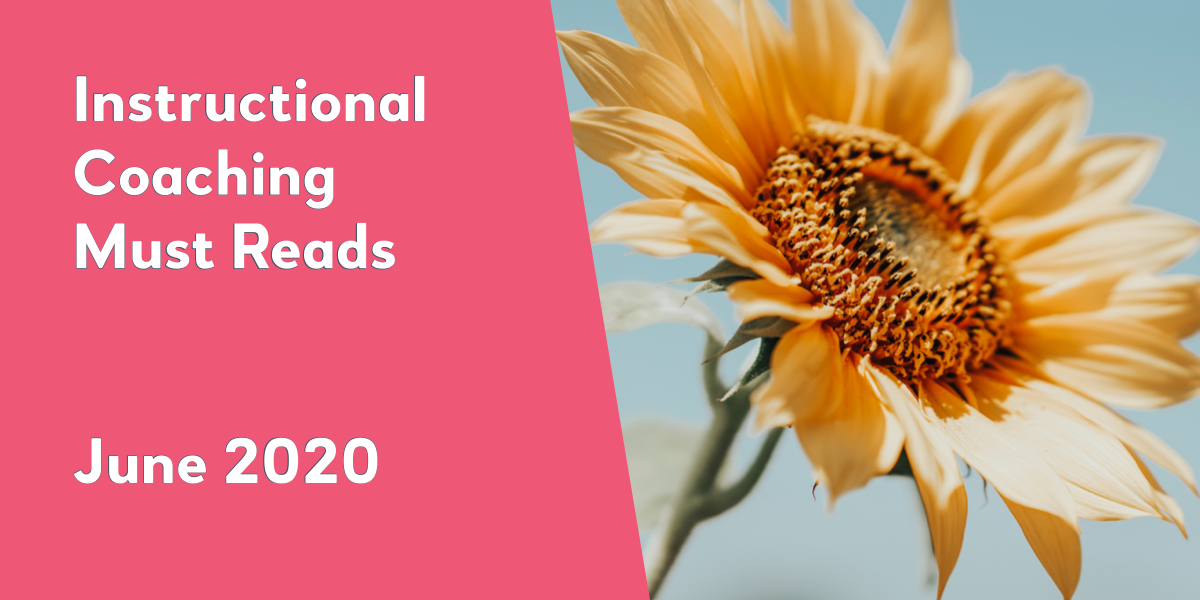


June not only wrapped up the 2019-20 school year but also brought the official start of summer! ☀️ Check out the top articles from June’s Weekly Coaching Roundups to learn how you can step up your approach to virtual coaching, tips for checking in with teachers remotely, a few foundational must-haves of coaching programs that work, and more. Enjoy!
Tired of waiting until the end of the month to read your coaching news? Join our weekly coaching roundup to get these sent directly to your inbox every week!
{{cta(’91e39d53-f5a0-42e6-8226-06f568821405′,’justifycenter’)}}
Step Up Your Approach to Virtual Coaching
If working from home has been a tough transition, you’re not alone! Kristi Sacha believes there are three major areas that ICs should focus their time on while working remotely—take a look!
“Now is also a perfect time to
partner with other coaches in your district and connect with the wider coaching community. . . . Connection is how we form those relationships: while working remotely, be proactive and
take the time to email or call teachers to check in and see how they’re doing. Be sure to ask if they have questions you can help address, or if they have any personal or health concerns you can assist with.”
Virtual Instructional Coaching
Amy Foley reflects on her experience working remotely and how she’s not only going to use her successes but also learn from her failures when planning for next year.
“In a virtual environment,
coaches need to support teachers and teams to collaborate effectively. This might mean developing/revising working agreements in order to ensure high functioning collaborative partnerships. It may also mean facilitating difficult conversations and team reflections. . . . Asking the right questions can leave a teacher feeling higher efficacy about what they have control over both in their personal and professional lives.”
Coming Back
Fiona Hurtado encourages ICs to focus on “bright spots” with teachers who are running on empty, especially when returning from adversity (COVID-19).
”
Things seem more complex for teachers. They are juggling new daily schedules, new duties, holding down a sense of normality while maintaining social distance and keeping masks in place. They are continuing to provide home learning engagements for students who cannot be in the classroom and bringing them in virtually whenever they can. . . .
Focusing on the bright spots – be they values, reflections, or the actions of others – might just help us to grow in this next stage of our COVID-19 experience.”
Tips for Checking-In with Teachers Remotely
Kelly Batts shares how promoting teacher feedback and communication among all levels of their organization was their district’s biggest win while shifting to distance learning.
“In the midst of the crisis, communication between all levels of our organization has been our biggest win.
What started out as a strategic way to check in on our teachers has turned into the foundation by which we are guiding our entire curriculum and instruction plans for the district moving forwards. . . . We dug deep into what we were observing during online instruction and shared our own perceptions about the needs of our educational community.”
Give TeachBoost Coach a try for FREE!
TeachBoost Coach supports remote coaching by helping ICs manage their coaching cycles, goals, meetings, and evidence. Additionally, coaches can upload resources and videos to keep everything in one place. Sign up below to try it out!
{{cta(‘997af1e4-1e4d-4d17-8c80-43a15a5af702’)}}
Coaching Choice Board
Kimberly Howard reflects on why Coaching Choice Boards appeal to her and how she might incorporate them into her coaching practice in the fall.
“A recent blog post by Pam Hubler has me thoughtfully considering how I want to provide assistance to my teachers. Pam created a coaching choice board that she uses to collect requests for her ‘services’ to teachers. . . . Next school year is sure to look different due to how COVID-19 has pushed us into a season of quarantine and remote learning.
Many of the teachers I serve are now much farther along in their technology integration competency and confidence than ever before. The focus can’t be tools, but how technology integration can be a regular part of their pedagogy.”
4 Ways to Become a Classroom Management Pro
Classroom management can create more instructional time and student learning. Christine Weis provides teachers with a few strategies for taking better control of their classrooms.
“Good classroom management results in more instructional time and more learning, improving student engagement, grades, and test scores. . . .
Relationships built on trust with students are critical to good classroom management. Students will do more for those educators they trust and respect. With building relationships comes investing time and energy in students that misbehave.”
Success Factors
Jim Knight and Matthew Kelly highlight seven foundational must-haves of coaching programs that work.
“Coaches and onsite professional developers often find themselves in high-stakes, critically important roles expected to lead school reform efforts with little or no professional preparation for successfully performing such tasks. . . . While every coaching situation presents unique challenges,
an established process for guiding the coaching experience ensures that instructional coaches have all the tools they need to help teachers set and achieve their goals.”
Bonus Infographic
Elena Aguilar put together an infographic of what she believes are the “6 masks of resistance,” plus four ways coaches can respond when faced with resistant teachers.
{{cta(’34b13594-505a-497a-8a75-16ae35acf14d’)}}
Have some interesting instructional leadership news?
Share it with TeachBoost and we’ll highlight it here.
Stay Connected
News, articles, and tips for meeting your district’s goals—delivered to your inbox.








